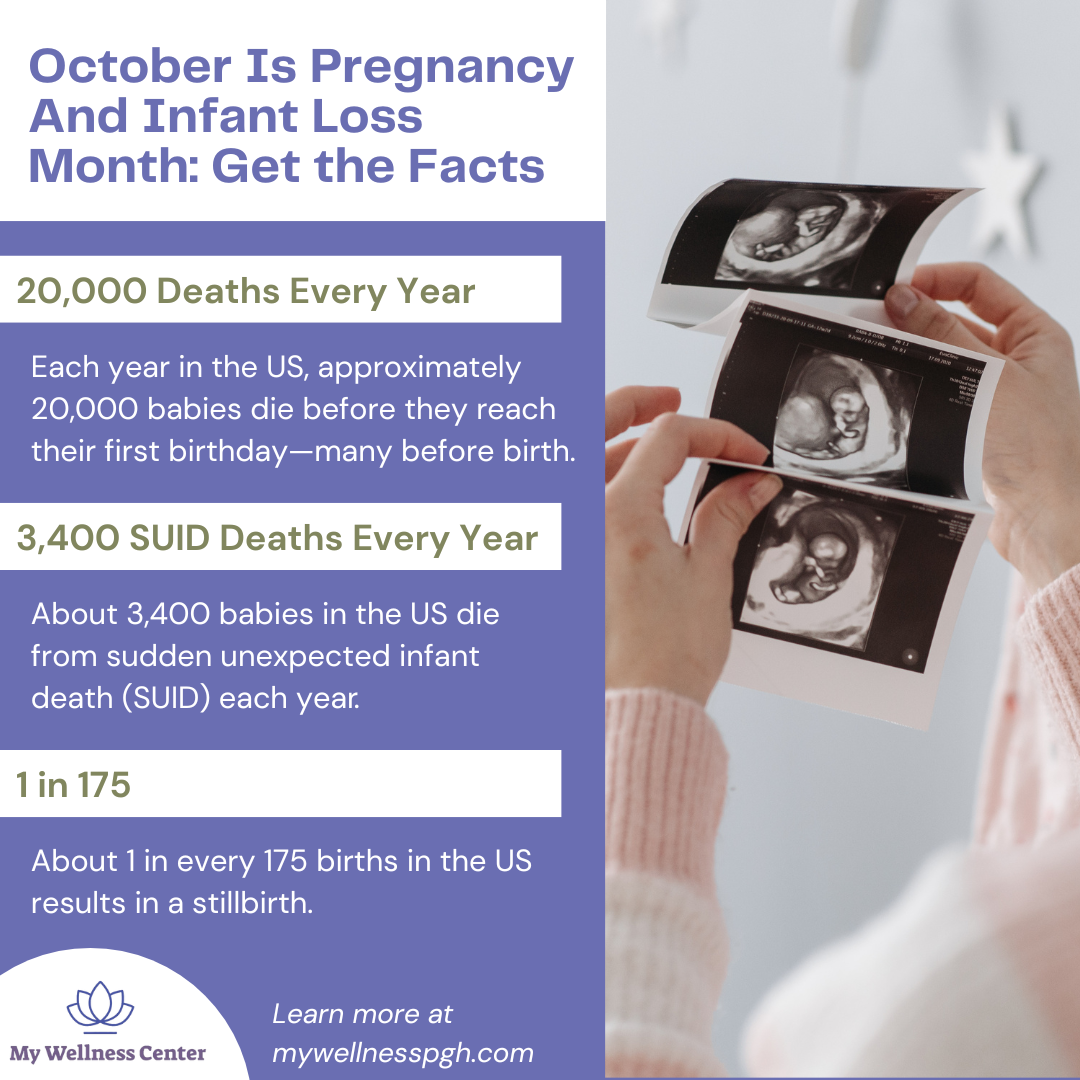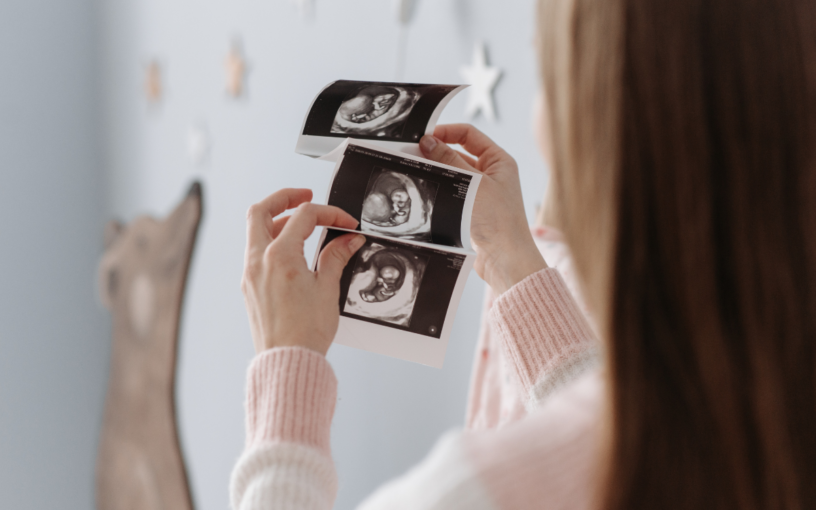October is Pregnancy And Infant Loss Awareness Month, making it a time to raise awareness about the realities of pregnancy loss, stillbirth, and infant death.
Although the United States health care system is often touted as the best in the world, it’s not perfect. Each year, about 20,000 babies die within the first 12 months of life in the United States.
It’s a devastating loss for parents.
That makes October the perfect time to remember three things:
- Parents and other family members appreciate emotional support if they’ve lost a child.
- In most cases of perinatal loss, it’s not the parent’s fault.
- Help is available.
Read our blog post to learn more about the facts and challenges of perinatal loss:
Primary Categories of Perinatal Loss
Challenges of Perinatal Loss
Treatment for Perinatal Loss
Find Therapy for Perinatal Loss

Primary Categories of Perinatal Loss
Experts generally break perinatal loss into five separate categories:
Infertility
Infertility is counted as a category in perinatal loss because most couples struggling with infertility don’t realize it’s a problem until they try to start a family.
Fortunately, infertility is becoming more and more treatable, with medications, surgeries, artificial insemination, surrogacy, and other options available to lend support.
Unfortunately, these treatments can be cost-prohibitive, and some adults may be less-than-ideal candidates for certain treatment methods. Learning you are incapable of having children with your partner can be a horrible, emotionally painful realization.
Fetal Death During Pregnancy
Miscarriage
Miscarriages can happen for a wide variety of reasons, and many of them are outside of a mother’s control. Common causes include:
- chromosomal abnormalities
- uterine or cervical problems
- hormone issues
- infections
- maternal health issues
- lifestyle factors
- trauma or injury
- environmental toxins
- obesity
- polycystic ovary syndrome (PCOS)
Any of these could lead to a potential miscarriage.
Medical Termination
Medical termination covers the termination of a pregnancy for one of two reasons:
- The pregnancy was medically dangerous to the mother.
- The pregnancy was unwanted or unintended.
Both cases can be emotionally devastating. While “abortion” is often used as a dirty word, it’s often a challenging decision for women—and it’s one that can be emotionally traumatic regardless of the logical reasons behind it.
Stillbirth
A stillbirth is when a baby is delivered when it has already passed away—and it impacts about 1 in 175 births in the United States, according to the CDC.
Most stillbirths are linked to some sort of problem in the placenta, but contributing factors may include:
- smoking
- diabetes (including gestational diabetes)
- high blood pressure (including preeclampsia)
- being overweight
- being 35 years or older
- being more than 41 weeks pregnant
Note: These are only risk factors—not indicators that you will lose a child during pregnancy.
Infant Death
Infant death has numerous definitions, but it generally covers the first year of life.
According to the World Health Organization, most (75%) neonatal deaths (those occurring within the first 28 days of life), happen within seven days after birth.
Another major concern is sudden unexpected infant death (SUID), which is when a baby passes away without warning. About 3,400 babies die from SUID every year in the US, and this includes those who die from SIDS—sudden infant death syndrome—which is sometimes called “crib death” because of how frequently it occurs while the baby is sleeping.
Challenges of Perinatal Loss
Losing a child—especially a baby—is one of the hardest things a person can go through. The love one feels for an infant is unique, and it can make the pain nearly unbearable.
Most notably, the loss of a baby is often met with three common symptoms:
1. Anxiety And Guilt
Many of the parents—especially the mothers—are riddled with anxiety and guilt.
The same questions run through their mind over and over again: What did I do wrong? Why couldn’t my body do what it was supposed to do? How could this have happened? Why me?
It’s normal for parents to blame themselves, but the simple fact is that in most cases, there was nothing they or anyone else could have done.
Medical science simply hasn’t come far enough to prevent every single perinatal death.
2. Fear Of Getting Pregnant Again
The trauma of perinatal death can cause some couples to completely abandon the idea of getting pregnant again. What if it happens again? What if I can’t carry a baby to term? What if something is wrong with me?
If a woman does get pregnant again, these same thoughts could plague her with anxiety—anxiety that’s bad for her physical health and the baby’s physical health.
In some cases, this fear (and any coinciding medical issues) can lead to voluntary childlessness—the decision not to have kids—or involuntary childlessness—the realization that kids aren’t a biological option.
3. Misconceptions About the Baby
We occasionally meet with mothers who still believe their deceased baby is still alive in a phenomenon called “phantom baby syndrome.” In phantom baby syndrome, a mother might sense the baby inside her own belly or the physical presence of the baby in the room.
This often appears as a coping mechanism after a loss, and it’s something that can be addressed through therapy.
Treatment for Perinatal Loss
Two of the best treatments for perinatal loss are therapy and medical treatment. Here’s what you should know about each one:
Therapy
Individuals suffering through the trauma of perinatal loss may benefit from two separate therapeutic approaches:
1. ACT Therapy – Acceptance and Commitment (ACT) therapy is the mindful practice of focusing on the present moment. Instead of focusing on loss, problems, or intense emotions, ACT pushes patients to center on solutions to their problems.
In the case of perinatal loss, potential solutions include medical intervention, building a wider support network, and accessing better resources for diet and exercise. Through therapy, we can work to explore the best solutions for your individual needs and lifestyle.
2. EMDR Therapy – Eye Movement Desensitization and Reprocessing (EMDR) therapy is a therapeutic technique that works by activating the brain as a patient works through the painful memories of loss.
This allows them to “rewire” their brain and disconnect the painful emotions from the memory itself.
Medical Treatment
If there is a medical reason why the child passed away—such as complications with preeclampsia or gestational diabetes during the pregnancy—proper medical intervention could provide additional support in a future pregnancy.
Being in Pittsburgh, we’re lucky to have so many women’s hospitals and fertility doctors in our region. Contact us if you’d like a referral!
Find Therapy for Perinatal Loss
If you’ve suffered the loss of a baby, we’re here for you. Our compassionate therapists are available to help you process losing your loved one.
Contact us today for a free consultation.

